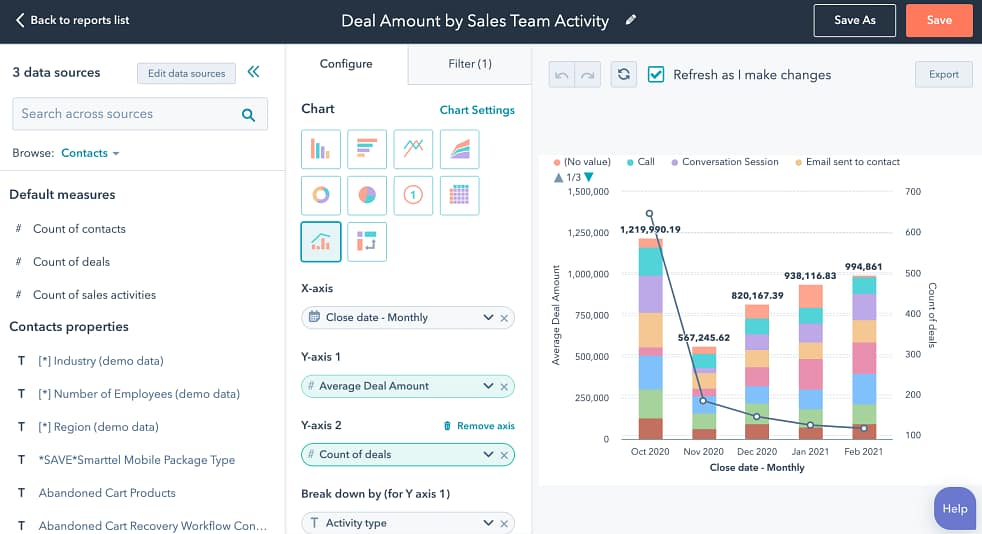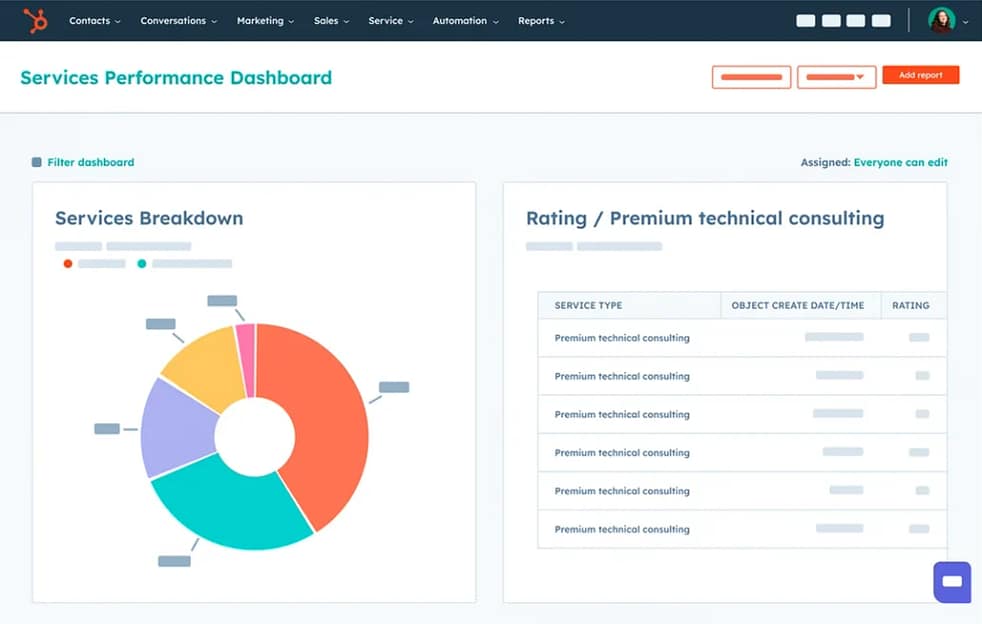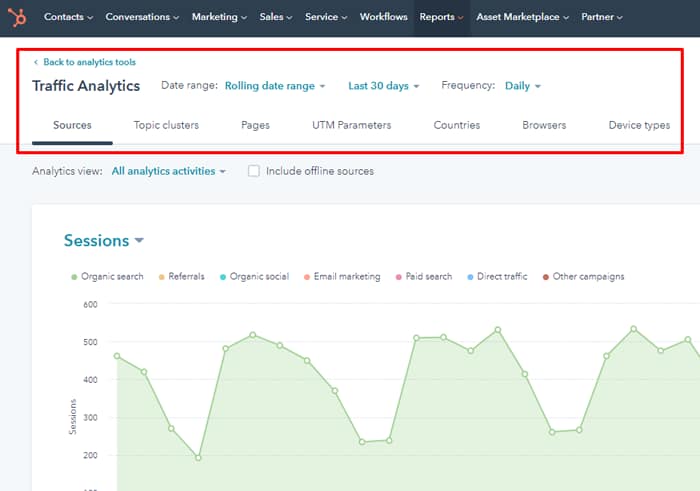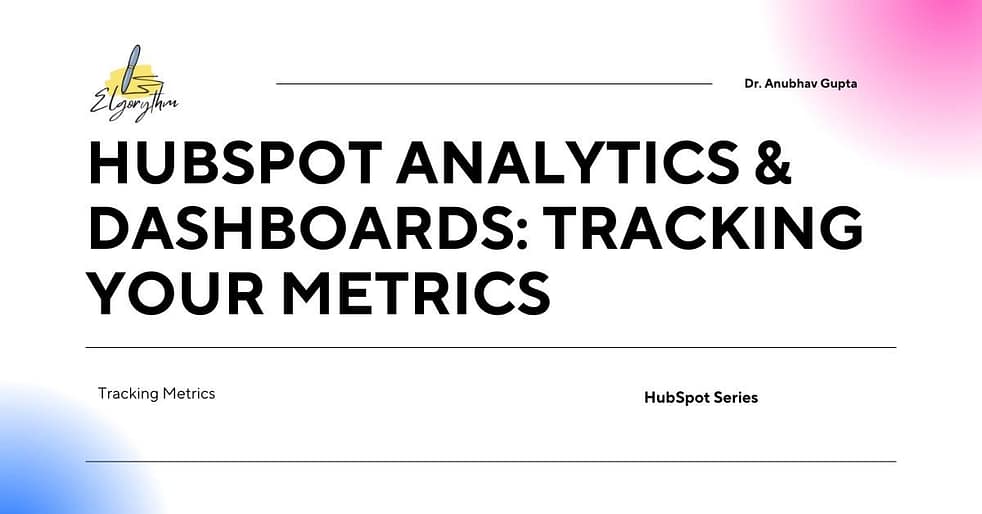HubSpot Analytics & Dashboards: Tracking Your Metrics
In today’s data-driven business environment, understanding your marketing performance and sales effectiveness is crucial for sustained growth. HubSpot analytics and dashboards provide comprehensive tools for tracking, measuring, and optimizing your business metrics, making it easier to make informed decisions that drive results.
This comprehensive guide explores how to leverage HubSpot’s powerful reporting tools and dashboard capabilities to transform raw data into actionable insights that fuel business growth.
Understanding HubSpot Analytics: A Complete Overview
HubSpot analytics serves as the central nervous system of your inbound marketing and sales efforts. Unlike standalone analytics tools, HubSpot integrates data from multiple touchpoints – marketing campaigns, sales activities, customer service interactions, and website performance – into a unified reporting platform.[1][2]
The platform offers several key analytics categories:
CRM Analytics | Hubspot Analytics
HubSpot’s CRM analytics provide deep insights into your sales pipeline, deal progression, and revenue generation. You can monitor sales activities, track conversion rates throughout the customer lifecycle, and analyze how leads move through your sales funnel.[2]
Marketing Analytics | Hubspot Analytics
Marketing analytics HubSpot tools help you measure campaign performance, track content engagement, and understand which channels drive the most qualified leads. These insights include email marketing performance, landing page conversions, social media engagement, and website traffic analysis.[3][4]
Web Traffic Analytics | Hubspot Analytics
HubSpot’s traffic analytics tool provides comprehensive website performance data, including traffic sources, device types, geographic locations, and visitor behavior patterns. This data helps you understand how users interact with your website and which content resonates most effectively.[5]

Building Effective HubSpot Dashboards | Hubspot Analytics
Creating Your First Dashboard
To build dashboards in HubSpot, follow this systematic approach:
- Navigate to Reporting > Dashboards in your HubSpot account
- Click “Create dashboard” to access the dashboard library
- Choose between pre-made templates or create a blank dashboard
- Select relevant reports and customize them according to your needs
- Set appropriate user access permissions[6][7]
HubSpot dashboard templates include specialized options for sales, marketing, service, and executive reporting, each containing pre-configured reports tailored to specific business functions.[8][6]
Dashboard Customization Best Practices
When customizing your dashboards, consider these essential practices:
Focus on One Primary Goal: Each dashboard should serve a specific purpose, whether it’s monitoring sales performance, tracking marketing ROI, or analyzing customer service metrics.[9][10]
Tell a Data Story: Arrange reports logically to create a coherent narrative about your business performance. Use text sections and descriptions to provide context and analysis.[9]
Keep It Simple: Limit dashboards to no more than 10 reports to avoid information overload. Too many metrics can dilute focus and make decision-making more difficult.[9]

Custom Report Builder
The custom report builder represents one of HubSpot’s most powerful analytics features. Available with Professional and Enterprise subscriptions, it allows you to analyze multiple data sources across HubSpot simultaneously.[11][12]
The custom report builder enables you to:
- Surface data from marketing and sales activities beyond basic object data
- Create cross-dataset reports showing relationships between different data types
- Build funnel reports that track conversion rates between lifecycle stages
- Generate attribution reports that reveal which touchpoints drive conversions[13][12]
Standard vs Custom Reports
Standard Reports provide quick insights into essential metrics covering website traffic, user engagement, sales activities, and customer service performance. These pre-configured reports are ideal for beginners or those needing basic analytics.[9]
Custom Reports offer deeper analysis capabilities, allowing you to pull data from multiple sources and create more nuanced views of your business operations. Examples include lead-to-close time analysis, customer acquisition cost tracking, and sales rep activity comparisons.[9]
Attribution Reporting
HubSpot’s attribution reporting helps you understand the complete customer journey by showing how different touchpoints contribute to conversions. Available attribution models include:
- First interaction attribution
- Last interaction attribution
- Linear attribution
- U-shaped attribution
- W-shaped attribution
- Multi-touch attribution[9]

Key Metrics to Track in Your HubSpot Analytics
Marketing Metrics
Essential marketing metrics to monitor include:
Lead Generation Metrics: Track conversion rates, lead quality scores, and cost per acquisition to assess campaign efficiency.[14][10]
Campaign Performance: Monitor email open rates, click-through rates, landing page conversions, and social media engagement.[14]
Content Analytics: Analyze blog performance, page views, time on page, and bounce rates to understand content effectiveness.[14]
Attribution Data: Identify which marketing channels and campaigns drive the highest-quality leads and revenue.[14]
Sales Metrics
Critical sales dashboard HubSpot CRM metrics include:
Pipeline Metrics: Monitor deal progression, average deal size, sales cycle length, and win rates.[15][16]
Activity Tracking: Measure call volumes, email interactions, meeting bookings, and task completions.[17]
Revenue Analytics: Track monthly recurring revenue (MRR), revenue churn, and forecasted revenue.[18]
Team Performance: Analyze individual rep performance, quota attainment, and productivity metrics.[15]
Website Analytics
Key website performance indicators encompass:
Traffic Metrics: Monitor website visits over time, traffic sources, and visitor geography.[14]
Engagement Data: Track page views, bounce rates, session duration, and conversion paths.[14]
Performance Metrics: Analyze page load times, mobile performance, and technical SEO factors.[14]
Advanced Analytics Features
Event Tracking and A/B Testing
HubSpot’s advanced analytics include sophisticated event tracking capabilities that monitor specific user actions on your website. You can track both traffic events (page visits) and click events (button clicks, form submissions) to understand user behavior patterns.[1]
A/B testing functionality allows you to test different versions of pages, emails, or campaigns to optimize performance. Professional and Enterprise users can create variants, run tests, and automatically implement winning variations.[1]
Customer Segmentation
HubSpot’s list tools enable sophisticated customer segmentation using various characteristics and activities. You can create:
- Active lists that automatically update based on defined criteria
- Static lists that capture contacts meeting criteria at a specific point in time[1]
These segmentation capabilities allow for more targeted reporting and personalized marketing efforts.
Goal Setting and Tracking
The platform’s goal-setting features help you establish and monitor specific objectives for individuals or teams. Available for Sales and Service Hub users, you can set goals based on revenue, calls logged, deals created, meetings booked, and service metrics like resolution times.[1]

Optimizing Your HubSpot Reporting Strategy
Integration with Other Tools
To maximize your HubSpot reporting tools guide effectiveness, consider integrating with complementary platforms:
Google Analytics Integration: Connect HubSpot with Google Analytics to combine CRM data with detailed website analytics.[19][14]
Third-Party Data Sources: Use tools like Supermetrics, Databox, or other reporting platforms to blend HubSpot data with additional marketing channels.[20]
Automation and Sharing
Automated Reporting: Set up recurring email reports to stakeholders, ensuring consistent communication about performance metrics.[21][9]
Dashboard Sharing: Configure appropriate access levels for different team members, from view-only permissions for executives to full editing rights for analysts.[21]
Best Practices for HubSpot Analytics Success
Data Quality and Consistency
Maintain high data quality by:
- Implementing consistent naming conventions for campaigns, deals, and contacts
- Regular data cleanup and deduplication
- Proper integration setup with external tools
- Training team members on data entry standards[22][9]
Strategic Reporting Approach
Be Deliberate and Strategic: Create reports with specific business questions in mind rather than tracking metrics for the sake of it.[22]
Simplify Your Approach: Focus on actionable metrics that directly impact business decisions rather than overwhelming dashboards with every available data point.[22]
Regular Analysis: Schedule regular review sessions to analyze trends, identify opportunities, and adjust strategies based on data insights.[9][14]
Frequently Asked Questions
How do I create a custom dashboard in HubSpot?
Navigate to Reports > Dashboards, click “Create dashboard,” choose a template or blank dashboard, add relevant reports, customize the layout, set user permissions, and save with a descriptive name.[23][6]
What’s the difference between HubSpot analytics and Google Analytics?
HubSpot provides a comprehensive view integrating marketing, sales, and service data, while Google Analytics focuses primarily on website traffic and user behavior. HubSpot offers better lead tracking and CRM integration.[14]
Can I track ROI from my marketing campaigns in HubSpot?
Yes, HubSpot’s attribution reporting and custom report builder allow you to track campaign ROI by connecting marketing activities to revenue outcomes through deal attribution and customer journey analysis.[9][14]
How often does HubSpot update reporting data?
HubSpot refreshes most reporting data every 40 minutes, though some real-time metrics update more frequently. Historical data may be reprocessed when additional information becomes available.[24]
What reports should I include in a sales dashboard?
Essential sales dashboard reports include deal forecast, pipeline analysis, sales performance by rep, recent activities, productivity metrics, and win/loss analysis.[16][17]
How do I share dashboards with my team?
You can share dashboards by setting visibility permissions (private, everyone, or specific users/teams), scheduling automated email reports, or exporting data for offline analysis.[21][9]
Can I track marketing qualified leads (MQLs) in HubSpot?
Yes, HubSpot’s lead scoring and lifecycle stage tracking allow you to identify and monitor MQLs through custom properties, workflow automation, and specialized reports.[18][14]
How do I measure content performance in HubSpot?
Use HubSpot’s content analytics to track blog performance, landing page conversions, page views, engagement time, social shares, and lead generation from specific content pieces.[14]
Conclusion
Mastering HubSpot analytics and dashboards requires a strategic approach that aligns data collection with business objectives. By implementing the practices outlined in this guide – from building focused dashboards to tracking the right metrics – you can transform raw data into actionable insights that drive measurable business growth.
The key to success lies in maintaining data quality, focusing on meaningful metrics, and regularly reviewing performance to identify optimization opportunities. Whether you’re tracking marketing campaign effectiveness, monitoring sales pipeline health, or analyzing customer behavior, HubSpot’s comprehensive analytics platform provides the tools necessary to make informed, data-driven decisions that propel your business forward.
CITATIONS
- https://userpilot.com/blog/hubspot-analytics/
- https://portable.io/learn/hubspot-analytics
- https://www.hubspot.com/products/marketing/analytics
- https://academy.hubspot.com/lessons/marketing-analytics-in-hubspot
- https://knowledge.hubspot.com/reports/analyze-your-site-traffic-with-the-traffic-analytics-tool
- https://www.youtube.com/watch?v=aHMfQ3LaYww
- https://knowledge.hubspot.com/dashboards/manage-your-dashboards
- https://support.webdew.com/kb/create-and-manage-dashboards-in-hubspot
- https://www.lyntonweb.com/inbound-marketing-blog/hubspot-custom-reports
- https://titan-one.co/blog/hubspot-reporting-best-practices
- https://knowledge.hubspot.com/reports/create-reports-with-the-custom-report-builder
- https://www.youtube.com/watch?v=jPYoDmddKDY
- https://www.youtube.com/watch?v=ai12CQvymPg
- https://www.helloroketto.com/articles/hubspot-analytics
- https://www.hublead.io/blog/hubspot-dashboard-examples
- https://blog.coupler.io/hubspot-sales-dashboard/
- https://www.avidlyagency.com/blog/sales-reporting-in-hubspot-our-favourite-dashboards
- https://agencyanalytics.com/blog/hubspot-metrics
- https://knowledge.hubspot.com/website-pages/integrate-google-analytics-with-hubspot-content
- https://portermetrics.com/en/compare/hubspot-reporting-tools/
- https://knowledge.hubspot.com/dashboards/customize-your-dashboards
- https://simplestrat.com/blog/hubspot-reporting-5-costly-mistakes-and-advice
- https://www.tripledart.com/marketing-tutorials/how-to-create-a-custom-dashboard-in-hubspot
- https://knowledge.hubspot.com/reports/traffic-analytics-faq
- https://databox.com/hubspot-reporting
- https://knowledge.hubspot.com/get-started/report-on-performance
- https://www.hubspot.com/products/reporting-dashboards
- https://www.youtube.com/watch?v=AjvOTO3PlZM
- https://knowledge.hubspot.com/reports/use-marketing-reports-in-the-marketing-analytics-suite
- https://blog.hubspot.com/sales/sales-dashboard
- https://ralfvanveen.com/en/seo/seo-for-hubspot-websites/
- https://www.seo.com/blog/hubspot-seo/
- https://www.trooinbound.com/blog/hubspot-reporting/
- https://lzcmarketing.com/blog/hubspot-seo-tools-and-features/
- https://www.ekeria.com/en/hubspot/blog/hubspot-seo
- https://www.hubspot.com/products/marketing/seo
- https://knowledge.hubspot.com/seo/view-seo-recommendations-in-hubspot
- https://elgorythm.in/mastering-answer-engine-optimization-aeo-book/
- https://elgorythm.in/category/seo/
- https://knowledge.hubspot.com/campaigns/campaigns-faq
- https://agencyanalytics.com/blog/hubspot-reporting-best-practices
- https://elgorythm.in
- https://knowledge.hubspot.com/prospects/prospects-frequently-asked-questions




